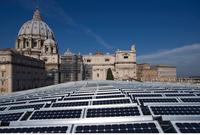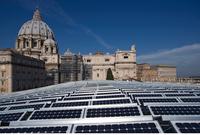Solar power from the Pope - and from space

The Vatican is entering the solar power business. In Santa Maria di Galeria, Europe's largest photovoltaic installation is to be erected by 2014. The Californian power supplier Pacific Gas & Electric has even greater plans: it wants to build the first solar power station in space by the year 2016.
In Santa Maria di Galeria, which is situated on the northern outskirts of Rome and is the location of Vatican Radio, a 100 megawatt installation that could supply electricity for 40,000 households is to be built by the year 2014. This corresponds to nine times the energy requirement of the broadcaster, which transmits as far as Asia. The power yield of the 500 million euro project would substantially exceed the needs of the Vatican state, which only has 900 inhabitants. The excess will probably be exported to its big neighbour, Italy.
Who exactly will erect the mammoth installation and whether mainly photovoltaics or thermal parabolic mirrors will be used is still unclear. The German company SolarWorld AG is being considered as the possible supplier. It has already built a solar system on the roof of the papal audience hall Paolo VI (completed in 2008). It supplies around 300,000 kWh of electricity per year, corresponding to the annual requirement of more than 100 households.
With its plans for the future- should they be realised -, the Californian company Pacific Gas & Electric will also be entering new territory or rather empty space. The power supplier wants to team up with Solaren, a start-up company, to build the first solar power station in space by 2016. This facility is intended to supply 200 megawatts of energy. The advantage of building in space is that the sun shines 24 hours a day; there is no such thing as night or cloudy skies up there. The "Space Solar Plant" is to be launched into space with satellites and will be based on the same technologies as communication satellites that have already been using photovoltaics to meet their energy needs for 45 years.
Critics, however, point out the obstacles in the way of the project, the cost of which is estimated to be more than 2 billion dollars. A single power-plant satellite would be ten times larger than ISS international space station which is already in orbit.
Who exactly will erect the mammoth installation and whether mainly photovoltaics or thermal parabolic mirrors will be used is still unclear. The German company SolarWorld AG is being considered as the possible supplier. It has already built a solar system on the roof of the papal audience hall Paolo VI (completed in 2008). It supplies around 300,000 kWh of electricity per year, corresponding to the annual requirement of more than 100 households.
With its plans for the future- should they be realised -, the Californian company Pacific Gas & Electric will also be entering new territory or rather empty space. The power supplier wants to team up with Solaren, a start-up company, to build the first solar power station in space by 2016. This facility is intended to supply 200 megawatts of energy. The advantage of building in space is that the sun shines 24 hours a day; there is no such thing as night or cloudy skies up there. The "Space Solar Plant" is to be launched into space with satellites and will be based on the same technologies as communication satellites that have already been using photovoltaics to meet their energy needs for 45 years.
Critics, however, point out the obstacles in the way of the project, the cost of which is estimated to be more than 2 billion dollars. A single power-plant satellite would be ten times larger than ISS international space station which is already in orbit.
